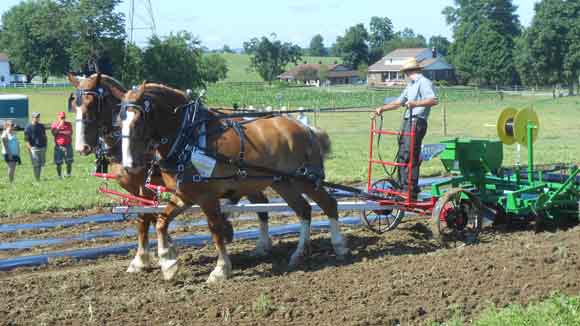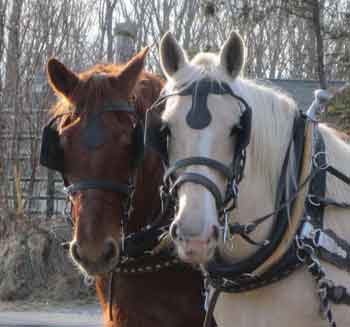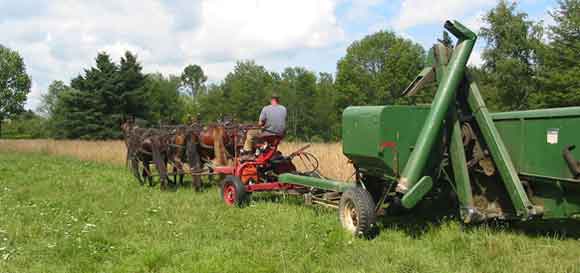Work Horses in a Market Garden: Part 3
The Best Horse for the Market Garden

Teamster Roundtable
The Best Horse for the Market Garden
Our first teamster in this discussion is Erika Marczak, who along with her partner, legendary plowman, Sam Rich, operates a working farm in Connecticut where they do a lot of their work with six Percherons and a team of working steers (not quite old enough to call oxen yet). They use their animals to hay, log, produce maple syrup, grow vegetables, and pretty much anything else that comes up on the farmstead.
Erika Marczak
Rabington Grown, Abington, Conn.

Klaus Karbaumer
Karbaumer Farm, Kansas City, Mo.

Mark Gillenwater
Providence Farm, Renick, W.V.

Jeroen Vos,
Jardin de l’Espérande, Gardes-Le Pontaroux, Charente, France
This is a discussion which always makes me smile. It is the analysis and the stories behind the choices which I find most interesting. In my case, I owned a breed (Brabançons) and started my market garden after moving to France. A team of 2,000-pound mares in the tiniest of market gardens may look a bit silly when starting, but I soon found out they can do anything if you can do it. Mine are not a matched team, one is speedy and pulls the cultivator like a big tree, so we take the other one for the delicate weeding of young plants. She walks slowly and, more importantly, puts her front feet down in a way that she does not throw up too much dirt on the young plants. Mrs. speedy gets her share of work on the forecart hauling manure to the garden and produce back. We use them as a team for plowing, and, after a while, they go well together. In winter they both go logging, where the added power is handy. Next year I hope to be working in the vineyards too, which will be interesting regarding their differences.

Don Hewes
Northland Sheep Dairy, Marathon, N.Y.
I am not a professional market garden person myself (primarily a grass and hay farmer), but we are doing a little cultivating each year. Obviously, if I am only going to cultivate for one or two days a year, and I will be looking between my legs trying to figure out which pedal is which, I will want my quietest slowest horse. But fast-forward a couple years to when we have increased the acreage – as well as our skills as teamsters and skills with the cultivating tool. It is hot, and there are still two acres to go; in that situation you will want a horse with a little more eagerness.
I don’t think size is the key, although I suppose someone could make a case for a certain size horse matching a certain size operation. Finally, I think good cultivating horses will come from careful study of the animal and task, and dedicated leadership to show them what we want.

Carl E. Lyndaker
Crystal Creek Ranch, Lowville, N.Y.
Horses are just like people: each one is different. They will do certain things better than others, and another horse will be just the opposite. Not that you can’t plow with a hitch horse or hitch with plow horse, but they will do one or the other a lot better. I know you can barrel race a draft and you can mow with a quarter horse, just not as good or efficient. It doesn’t have to be different breeds, just their temperament and actions can make a big difference. That being said, you can train just about any horse to do what you want, just maybe not as good or efficient as another horse.
Brian McGinness
Riverbound CSA, Mandan, N.D.
Speaking as relative beginner who has been market gardening full-time with horses for four years, my opinion is that the best horses for me were older, very settled, been-there-done-that horses that knew the ropes. Cultivating is obviously a touchy operation, and your hard work in the greenhouse, on the transplanter, etc., can easily be destroyed with a little drift out of line. It’s my favorite job with the horses, but that’s because my horses are steady, will go slow, and aren’t afraid. They’re not brain dead or anything, but they follow the leader. Mine happen to be Belgians, and I am trying out some smaller-footed mules this season, but the key for me getting started was work with 18-year-old horses who knew how to be driven.
Michael Wilson
Horse logger and blacksmith, Bluemont, Va.
Forty years or more ago, a savvy old man (late 80s then), who had a feed and grain warehouse, and tack and harness store in New Milford, Conn., shared some information with me that I have never forgotten. Perry Green had lived through the peak and the nadir of draft horses in America. Even during the worst times, he always had good heavy harness for sale, one of the few who bothered.
At that time, 18 hands high horses were still considered very large. He said, "Michael, America was farmed, logged, and freighted with 1,200 to 1,400-pound horses." He thought that the quest for ever bigger horses was ridiculous, particularly for practical working and hobby models. They were too expensive to keep, too hard to harness, and did not do enough more than smaller horses to justify their use. Today, although it is hard to find a 1,500-pound, 16 hands high or under Belgian or Percheron, one can find good Suffolks, Fjords, working type Haflingers, and crossbreds that will get the job done. And they are not worn out at the end of the day just from carrying their own big bodies around. If you have been led to believe that performance is commensurate with size, I'd suggest that you compare loads pulled at the pulling contests by lightweight teams compared to the open division horses.
Think twice about “big” horses, and consider the many attributes of the “big little” horse. Smaller work horses can make up for what they may lack in brute strength with stamina and hardiness. You may find that, in comparison to a great little team, a pair of bruisers may turn out to be too expensive to keep without getting any more production.
I believe a pretty clear consensus has emerged from our teamster roundtable:
the “Best” horse for the market garden is not a matter
of breed, nor size or conformation. It boils down
to temperament, tractability, and willingness and
leads to questions about a particular horse’s
character and the teamster’s personal chemistry
with that character.
As in many questions dealing with real life and living beings, there are simply no simple answers.
We use our horses, we expect them to do the work for us, and we expect them to behave for us. However, in the course of our day-to-day commitment to running our farms with draft horse power, we also become fond of them. We can become quite attached to horses that have been with us for a long time, and, when they pass, they leave us with many great memories. I have heard of a theory that posits that all horse owners have a chance of finding a “lifetime horse.” Once in a lifetime, if we are very lucky, we find a certain special horse.
When we work with a tractor to till our land, the powers and limits of that machine’s functions are pretty much a mechanical-given inherent to its design. Some equipment operators will be more skilled than others, but, when we sit down on that tractor seat and turn the key, we pretty much know what we can and can’t do with it. Not so with a horse or a team. If we are open to the adventure, throughout their working life our horses will continue to surprise us with how much they can develop and sharpen their abilities and skills, how they can master new skills, how they can help train in young horses and even help train novice teamsters. And, we may even say, how they are able to acquire their own equine brand of wisdom.
Although I have been working draft horses most of my adult life, I struck gold early in my career. My “lifetime horse” is one that I have had since the first year I began driving horses more than 20 years ago. We brought this mare to the farm when she was a 4-month-old weanling, and she is still with us. She is honest, dependable, willing, not an overly demonstrative animal, even aloof at times, but always ready to do her best when the collar and bridle come out. We know what to expect from each other, and that simple fact, the result of years of working together, creates something very potent that just can’t happen with a tractor. You could say that I love this horse, but, more to the point, she has earned my respect.
Farming with draft animals persisted in back waters of North America for several decades after World War II. Then the “back-to-the-land” movement of the 1960s and 70s stirred a renewed interest in the utility of animal traction on the small farm. Certain brewery companies have played an important role in keeping the tradition of the draft cart horse in the public eye, as have urban teamsters that drive their draft horses on public coaches and carriages and sleighs. The role of avid hobbyists, and all those who bring draft horses and oxen to shows, parades, pulling contests, plow matches and county fairs has also been a noteworthy factor in keeping the knowledge and skills of the teamster trade alive. And, of course, the tenacious persistence of Amish and Mennonite communities in farming with draft horses has been, and still remains, an absolutely crucial reservoir for preserving (and continuing to develop) the culture of the draft horse. In our times, concurrent with the rise of organic farming, there has been a small but steadily growing number of farmers who choose to go “beyond organic” by farming or ranching with horses, mules, or oxen.
As a species, our association with horses extends back across countless centuries. Our ancestors left traces of this fascination in pigmented contours brushed upon the cave walls of southern France some 30,000 years ago. Even in this age, where diesel-guzzling mechanical behemoths can get the work done so quickly, there is still something embedded in our DNA that compels some of us to want to entwine our lives and labors with these denizens of the wind. ![]()
More Articles in this series:
Part 1 History of the Horse takes a glance at the history of the equine species and the cultural forces that shaped the modern draft horse.
Part 2 Draft Horse Breeds takes a look at some of the most popular breeds of draft horses in use today on North American farms, with an eye towards the characteristics best suited to work in the market garden.
This article appeared in the October/November 2014 issue of Rural Heritage magazine.
